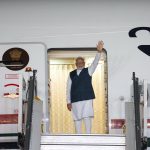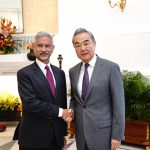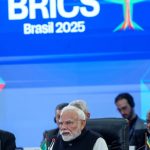 KATHMANDU: Amid China’s moves to deepen its forays into the region, Prime Minister Narendra Modi has repositioned India in the leadership role in the SAARC, with a clear message that India will move ahead with regional integration process, with or without SAARC. In fact, India’s ‘enhanced’ South Asia diplomacy is set for a major upsurge with Afghan President Ashraf Ghani and Bhutan’s Prime Minister Tshering Tobgay travelling to the country early next year and Mr Modi planning bilateral trips to Bangladesh, Sri Lanka and the Maldives in the coming months.
KATHMANDU: Amid China’s moves to deepen its forays into the region, Prime Minister Narendra Modi has repositioned India in the leadership role in the SAARC, with a clear message that India will move ahead with regional integration process, with or without SAARC. In fact, India’s ‘enhanced’ South Asia diplomacy is set for a major upsurge with Afghan President Ashraf Ghani and Bhutan’s Prime Minister Tshering Tobgay travelling to the country early next year and Mr Modi planning bilateral trips to Bangladesh, Sri Lanka and the Maldives in the coming months.
On the sidelines of the 18th SAARC summit in the Nepali capital Kathmandu, Prime Minister Modi held wide-ranging bilateral talks with the leaders of Nepal, Afghanistan, Sri Lanka, Bangladesh, the Maldives and Bhutan November 25-26.
What came across these meetings clearly was the desire of all South Asian countries, barring Pakistan, to re-energize SAARC and an acknowledgement of India’s leadership role in propelling the region towards deeper integration and fructifying the promise of a reawakened region brimming with new opportunities. “The general trend that we noticed was that several of the leaders who met him (Prime Minister Modi) complimented him for his forward-looking vision for South Asian cooperation,” Syed Akbaruddin, the spokesperson of India’s external affairs ministry, told journalists in Kathmandu November 26.
 “Some of them said that South Asia was looking for Indian leadership; India’s leadership was essential; it was necessary,” said the spokesperson. The operative words here are “essential” and “necessary,” underscoring that the region is looking at the resurgent India growth story as an opportunity and feels that it helps to have a collective stake in the India story as the entire region grows through win-win cooperation. Predictably, this narrative is not shared by Pakistan, a perpetual naysayer in the grouping which feels a sense of threat from India’s natural leadership role in the region. But in persisting with this negativity, Pakistan is only going to accentuate its marginalization as all SAARC leaders expressed their disappointment at Islamabad’s stalling of three key SAARC pacts on road and rail connectivity and energy cooperation.
“Some of them said that South Asia was looking for Indian leadership; India’s leadership was essential; it was necessary,” said the spokesperson. The operative words here are “essential” and “necessary,” underscoring that the region is looking at the resurgent India growth story as an opportunity and feels that it helps to have a collective stake in the India story as the entire region grows through win-win cooperation. Predictably, this narrative is not shared by Pakistan, a perpetual naysayer in the grouping which feels a sense of threat from India’s natural leadership role in the region. But in persisting with this negativity, Pakistan is only going to accentuate its marginalization as all SAARC leaders expressed their disappointment at Islamabad’s stalling of three key SAARC pacts on road and rail connectivity and energy cooperation.
Two-Way Visits
Refreshingly, India is unfazed by Pakistan’s negativity and is set to galvanize its South Asia diplomacy by backing words with deeds. This enhanced South Asia policy will be reflected in a spate of two-way visits.
The South Asia diplomatic calendar in 2015 kicks off with a visit by Bhutan’s prime minister in January, where he is expected to attend the Vibrant Gujarat summit, a business conclave that Mr Modi, when he was the chief minister of Gujarat, leveraged to promote hefty foreign investments into India’s western state. This will be followed by the maiden visit by Afghan President Ghani early next year. Mr Ghani’s visit will be crucial as it will happen amid the unfolding transition in his country in the wake of the withdrawal of foreign combat troops. India has enormous stakes in peace and stability of Afghanistan and will be looking to work closely with the Afghan leader to prevent that country slipping into an endless spiral of violence that could provide a window to the Taliban and their masters across the border to fish in troubled waters. In their discussions November 26, the two leaders discussed the threat of terror attacks, with the Afghan president assuring the Indian leader of the security of its consulates in his country.
Mr Modi has accepted invitations to visit Sri Lanka, the Maldives and Bangladesh, which he plans to do next year. The three countries are being actively courted by China which has showered them with massive aid and developmental assistance.
Apart from accelerating commerce and connectivity with South Asian countries, India will also be looking to deepen strategic and security ties with South Asian neighbours, which has acquired a new urgency with China deepening its footprints in India’s periphery. In this context, National Security Adviser Ajit Doval’s forthcoming visits to the Maldives and Sri Lanka to expand maritime security cooperation will be crucial, and will be watched closely by China that is trying to seduce South Asia with its Maritime Silk Road strategy.
Much to the dismay of India, the Maldives and Sri Lanka signalled their willingness to join the Maritime Silk Road during Chinese President Xi Jinping’s trip to the two countries in September this year.
Pitching for a larger role in SAARC, where China currently is one of nine obseervers, Chinese Vice-Foreign Minister Liu Zhenmin said at the SAARC summit plenary that China is ready to further deepen cooperation, elevate relations with Saarc and contribute to peace, stability and prosperity in South Asia. During his visit, President Xi had unveiled a host of initiatives to tighten Beijing’s embrace of willing players in South Asia, including increasing Chinese trade with the region to $150 billion; investment to the tune of $30 billion in the next five years and pledged $20 billion in concessional loans.
(Manish Chand is Editor-in-Chief of India Writes Network, www.indiawrites.org, a portal and e-journal focused on international affairs and the India Story. He is in Kathmandu to report and analyse the 18th SAARC summit)
Author Profile

- Manish Chand is Founder and Editor-in-Chief of India Writes Network (www.indiawrites.org) and India and World, a pioneering magazine focused on international affairs. He is CEO, Centre for Global India Insights, an India-based think tank focused on global affairs.
Latest entries
 DiplomacyAugust 29, 2025Ahead of China visit, Modi eyes Japan opportunity
DiplomacyAugust 29, 2025Ahead of China visit, Modi eyes Japan opportunity India and the WorldAugust 27, 2025SCO summit: ‘Tianjin Test’ for India’s terror concerns
India and the WorldAugust 27, 2025SCO summit: ‘Tianjin Test’ for India’s terror concerns India and the WorldAugust 19, 2025Ahead of PM Modi’s visit, China strikes positive note on rare earths, de-escalation
India and the WorldAugust 19, 2025Ahead of PM Modi’s visit, China strikes positive note on rare earths, de-escalation India and the WorldJuly 7, 2025BRICS boost for India, Modi calls out double standards on terror
India and the WorldJuly 7, 2025BRICS boost for India, Modi calls out double standards on terror








